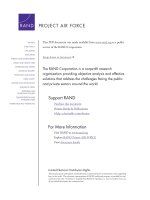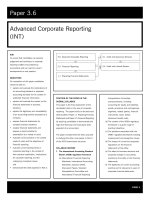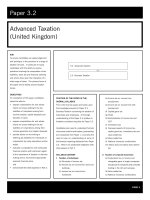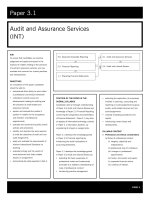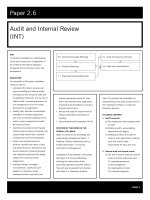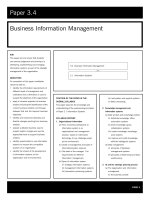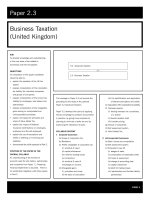acca test book Strategic Business Planning and Development pot
Bạn đang xem bản rút gọn của tài liệu. Xem và tải ngay bản đầy đủ của tài liệu tại đây (362.82 KB, 11 trang )
PAGE 3
AIM
To ensure that candidates can exercise
judgement and technique in strategic
business management to enable them to
contribute to the formulation of business
strategy, the development of products and
services and the maintenance of quality
throughout the organisation.
OBJECTIVES
On completion of this paper candidates
should be able to:
• identify and apply the principal
concepts and ideas in the theory and
practice of strategic management
• understand the internal and external
factors affecting an organisation and
apply this knowledge to evaluate its
strategic position
• identify appropriate strategies based on
the evaluation of the organisation’s
objectives and position
• identify the appropriate methods of
implementing chosen strategies and
evaluate their impact on organisational
structures and operations
• understand the impact of globalisation
on strategic business planning
• integrate knowledge effectively and use
it creatively in applying concepts and
techniques
• analyse, interpret and apply data and
information and present reasoned
conclusions
Paper 3.5
Strategic Business Planning
and Development
• communicate analyses and conclusions
effectively and with sensitivity for different
purposes and contrasting audiences with
due emphasis on social expectations.
POSITION OF THE PAPER IN THE
OVERALL SYLLABUS
Candidates should have a sound
understanding of Paper 1.1 Preparing
Financial Statements and 1.2 Financial
Information for Management, Paper 1.3
Managing People and Paper 2.1 Information
Systems. The information in these papers
will provide some of the basic material for
strategy analysis and development.
Paper 3.5 builds upon the knowledge
obtained in Paper 1.3 by
• reinforcing the importance of
recruitment and selection processes and
procedures
• examining the importance of training
and development and motivation within
a strategic context
• providing a more strategic view of
human resource issues
• extending the coverage of work
organisations.
Paper 3.5 develops parts of the knowledge
gained in Paper 1.1 and 1.2 by
• applying and interpreting financial
information for strategy evaluation and
strategy recommendation
• giving more emphasis on pricing
policies and procedures
• examining performance measurement
criteria.
Paper 3.5 develops parts of the knowledge
obtained in Paper 2.1 by
• reinforcing the knowledge of managing
information systems at a strategic level.
Although much of the knowledge gained in
Part 3 will be specific to the individual
papers, Paper 3.5 will, by its very nature,
provide integration with most of the other
papers at this level.
In Paper 3.1 Audit and Assurance Services
there will be links with professional and
ethical considerations.
In Paper 3.3 Performance Management
there will be strong relationships with areas
on performance measurement and
decision-making.
In Paper 3.4 Business Information
Management there will be related material
on information resource management and
information systems and competition.
In Paper 3.7 Strategic Financial Management
there will be relationships with objectives and
corporate governance, strategy formulation
and the global economic environment.
PAGE 4
Paper 3.5: Strategic Business Planning and Development (Continued)
SYLLABUS CONTENT
1 Models of strategic
management
(a) What is strategic management?
(i) corporate strategy
(ii) business strategy
(b) Why is strategic management
important?
(c) The process, content and context of
strategic management.
(d) Process of strategy development
(i) deliberate or prescriptive strategies
(ii) emergent and incremental
strategies.
(e) Strategic content
(i) strategic analysis
(ii) strategic choice
(iii) strategic implementation.
(f) Strategic management in different
contexts
(i) configuration
(ii) culture.
2 External environmental
scanning
(a) Analysis of the general environment
(i) SLEPT analysis
(ii) Porter’s diamond
(iii) forecasting and scenarios.
(b) Analysis of the customers and
markets – marketing research.
(c) Analysis of the competitive
environment
(i) five forces model
(ii) competition and collaboration
(iii) competitor intelligence for
business advantage
(iv)sustainable competitive advantage
and critical success factors.
3 Internal assessment
(a) Resource audit.
(b) Analysis of capabilities and core
competences.
(c) Adding competitive value – value
chain and value system.
(d) Analysis of human resources.
(e) Analysis of financial resources.
(f) Analysis of operations resources.
4 The nature of strategy analysis and choice
(a) The purpose of the organisation
(i) stakeholder expectations
(ii) cultural context
(iii) mission, objectives and strategic
intent.
(b) Developing the strategy
(i) alternative directions for strategy
development
– resource based
– market based
– finance based
(ii) methods of strategy development
– internal development
– strategic alliances
– mergers and acquisitions.
(c) Strategy evaluation and selection
(i) analysis of suitability, feasibility
and acceptability
(ii) corporate/ business strategy
selection.
5 The nature of strategy
implementation
(a) Marketing issues
(i) segmentation, targeting and
positioning
(ii) strategies for market leaders,
followers, challengers and nichers
(iii) development and application of
marketing mix strategies.
(b) Finance issues
(i) performance evaluation
(ii) funding the implementation and
the resource allocation.
(c) Research and Development issues
(i) management of innovation
(ii) management and control of quality.
(d) IS/ IT issues
(i) IT/ IS as a strategic resource
(ii) the management of information
systems development.
(e) HR issues
(i) recruitment and selection
(ii) motivation and discipline
(iii) appraisal and performance
evaluation
(iv) staff training and development.
(f) Project management issues
(i) the project life cycle
(ii) objectives of project management
(iii) estimation of resource
requirements
(iv)tools and techniques of project
management.
(g) Management of change issues
(i) understanding the types of
strategic change and their causes
Strategic Business Planning and Development (Continued)
PAGE 5
(ii) development of a strategic
change programme
– power influence
– culture influence
(iii) management roles in the
strategy change process
(iv) managing the strategic change
process.
6 Matching structures with
strategy
(a) Types of organisation structures
(i) simple
(ii) functional
(iii) divisional
(iv) matrix
(v) multinational
(vi) global
(vii) strategic business unit.
(b) Centralisation versus decentralisation.
(c) Organisational configurations.
7 The nature of global
competition
(a) The role of traditional international
marketing.
(b) The development of the global
business
(i) market convergence
(ii) cost advantages
(iii) government pressures
(iv) currency volatility and trade barriers
(v) the emergence of global
competition.
(c) Global strategies
(i) standardisation versus
customisation
(ii) product positioning
(iii) channel management
(v) the development of global brands.
(d) Managing a global company
(i) ethnocentric, polycentric or
geocentric orientation
(ii) cross cultural management and
leadership.
(e) Reaching global customers
(i) international marketing research
(ii) international market segmentation.
8 Outcomes of the strategic management
process
(a) Corporate versus business
performance
(b) Sustainable competitive advantage
(c) A learning organisation
(d) Alternative performance measures:
(i) financial
(ii) non financial
(iii) strategic.
9 Ethical considerations
(a) The importance of social responsibility.
(b) Corporate governance.
(c) The attitude towards ethics on
national and global scales.
EXCLUDED TOPICS
The syllabus content outlines the areas for
assessment. No areas of knowledge are
specifically excluded from the syllabus.
KEY AREAS OF THE SYLLABUS
Although all the syllabus will be examined in
some form, the core areas will be focused on
the strategy formulation process. This
comprises the identification of corporate
objectives, strategic analysis, including
internal and external reviews, strategy
development, evaluation and implementation.
APPROACH TO EXAMINING THE
SYLLABUS
Primarily the subject – Strategic Business
Planning and Business Development – will
be considered at the strategic level. All
aspects will be considered in terms of
practical application. Wherever possible
the subject will be integrated and not
considered as a collection of isolated
topics. Operational activities will only be
introduced where they impinge upon
strategic considerations.
The examination is a three hour paper in
two sections. Section A will be in the
format of one major case study, usually
with four question parts. This will be
compulsory and will focus on the core
material, previously described, although
other aspects of the syllabus could be
introduced here. Questions will be mainly
discursive but there will usually be some
financial or other quantitative data included
here to be analysed. Candidates are
expected to closely relate all their answers
to the case scenario. Section B will consist
of a choice of two questions, each of two
parts, from a total of three available.
Strategic Business Planning and Development (Continued)
PAGE 6
They will not be linked to the compulsory
case scenario, but may include short
scenarios to be discussed in context.
Number
of Marks
Section A: One compulsory
question 60
Section B: Choice of 2 from 3
questions (20 marks each) 40
100
ADDITIONAL INFORMATION
The Study Guide provides more detailed
guidance on the syllabus.
RELEVANT TEXTS
There are a number of sources from which
you can obtain a series of materials written
for the ACCA examinations. These are
listed below:
Foulks Lynch – ACCA's official publisher
Contact number: +44 (0)20 8831 9990.
Website: www.foulkslynch.com
Accountancy Tuition Centre (ATC)
International
Contact number: +44 (0)141 880 6469.
Website: www.ptc-global.com
BPP
Contact number: +44 (0)20 8740 2211.
Website: www.bpp.com
Strategic Business Planning and Development (Continued)
STUDY SESSIONS
OVERVIEW OF STRATEGIC
MANAGEMENT
1 Introduction to strategic
management
(a) Strategic managment defined
(i) corporate strategy
– understand the strategic
perspective
– evaluate the overall purpose
and scope
– describe the expectations of
owners
– describe the expectations of
stakeholders
– explain the concept of added
value
(ii) business strategy
– be aware of the role of
business units
– identify market competition
(b) The importance of strategic
management
(i) define strategy and strategic
thinking
(ii) differentiate between policy,
strategy, tactics
(iii) understand the need for a long
term view
(iv) define long term objectives
(v) explain controlling the future
(vi) understand long term efficiency
The Financial Training Company
Contact number: +44 (0)174 785 4302.
Website: www.financial-training.com
Candidates may also find the following
texts useful:
Johnson and Scholes Exploring Corporate
Strategy (6th edition) Prentice Hall Europe
Grant Contemporary Strategy Analysis:
Concepts, Techniques, Applications (4th
Edition) Brackwell Publisher ISBN
0631207 805
Other texts which may be useful to
candidates:
Joyce and Woods Strategic Management
Kogan Page ISBN 0749435836
Wilson and Gilligan Strategic Marketing
Management: Planning, Implementation
and Control (2nd edition)
Butterworth-Heinemann ISBN
075062244X
Keegan Global Marketing Management
Prentice Hall (6th edition) ISBN
0139030239
Wider reading is also desirable, especially
regular study of relevant articles in ACCA's
student accountant.
PAGE 7
Strategic Business Planning and Development (Continued)
(c) The process, content and context of
strategic management
(i) describe the present position of
the organisation
(ii) understand the external
environment
(iii) understand the organisation at
present
(iv)evaluate where does the
organisation want to be
(v) demonstrate how is the
organisation going to get there
(d) The process of strategy development
(i) identify deliberate strategies
(ii) identify prescriptive strategies
(iii) identify emergent and
incremental strategies
(iv) understand strategic planning
and strategic management
2 The rational model
(a) strategic analysis
(i) assess the strategic position
(ii) evaluate expectations and
influence of stakeholders
(b) strategic choice
(i) define underlying influences
which guide strategy
(ii) evaluate strategic options
(iii)understand evaluation and
selection procedures
(c) strategic implementation
(i) define resource planning
(ii) define corporate strategy
(iii) define business strategy
(iv) define operational and financial
strategy
3 Strategic management in context
(a) Strategic configuration
(i) understand logical incremental
model
(ii) understand rational command
model
(iii) understand cultural political
influences
(iv) understand political choice
4 Culture
(a) Define the meaning of culture
(b) Understand the determinants of
culture: Schein
(c) Describe the cultural web: Johnson
and Scholes
(d) Link culture with structure
(e) Discuss models of culture: Handy,
Miles and Snow, Peters and
Waterman, Mintzberg
(f) Understand changing organisational
culture: Kanter, Lewin
(g) Evaluate the link between culture
and strategic leadership
(h) Identify regional and national culture
5 External environmental scanning
(a) Analysis of the general environment
(i) SLEPT analysis
– be aware the social impact on
the organisation
– be aware of the legal issues
and implications
– be aware of the role and
influence of the economy
– be aware of the political
environment
– be aware of the impact of
technology
– be aware of complexity,
dynamism and uncertainty
– understand systems thinking
– analyse the organisation as an
open system
– understand the focal zone analysis
(ii) Porter’s diamond
– explain firm strategy, structure
and rivalry
– explain demand conditions
– explain factor conditions
– explain related and supporting
industries
(iii) forecasting and scenarios
– understand strategic life cycles
– understand statistical forecasting
techniques
– understand the delphi technique
– understand scenario planning
6 Analysis of customers, markets and
marketing research
(a) Explain aggregate and sectoral
concentration
(b) Understand customer behaviour
(c) Understand the principles of
marketing research
(d) Explain market research as a
component of marketing research
(e) Discuss social change and social
trends
(f) Discuss demographic factors
(g) Discuss population size
(h) Discuss demographic change
(i) Discuss social structure
PAGE 8
(j) Discuss economic change
(k) Analysis of the competitive
environment
(i) the five forces model
– understand the general model
– discuss intensity of rivalry
among existing competitors
– discuss bargaining power of
suppliers
– discuss bargaining power of
buyers
– discuss the threat of new
entrants
– discuss the threat of
substitutes
– evaluate the weaknesses of
the model
– explain the threat of potential
entrants
– understand the connection
with market structure
– discuss the role of government
and regulation
(ii) competition and collaboration
– review government regulation
– discuss the competition
commission
– compare different market
environments
– discuss cartels, oligopolies
7 Competitor intelligence for business
advantage
(a) Understand the portfolio analysis
approach
(b) Describe the Boston Consulting
Group model
(c) Describe the Shell directional policy
matrix/nine cell grid
(d) Understand the importance of
understanding portfolio analysis
(e) Understand the product life cycle
(f) Explain competitor benchmarking
(g) Explain competitive positioning grid
(h) Sustainable competitive advantage
(i) define competitive advantage
(ii) explain competitive advantage
(iii) discuss generic strategies
(Porter)
(iv)understand different approaches
by management
(v) evaluate branding, patents,
copyrights and trademarks
(vi) identify national advantage
(Porter)
(vii) evaluate the strategic role of the
marketing mix
(i) Critical success factors
(i) define how to measure success
(ii) compare actual and relative
success factors
(iii) compare efficiency and
effectiveness
(iv) evaluate financial measures
(v) contrast the expectations of stock
holders and shareholders
(vi)discuss quality issues
(vii) evaluate success measurement
for non profit making organisations
8 Internal assessment
(a) Resource audit
(i) identify the quality, nature and
extent of available resources
(ii) identify physical, human and
financial resources
(iii) identify intangible resources
(iv) understand unique resources
and competitive advantage
(v) evaluate internal control systems
(vi) analyse departmental
organisation
(b) Analysis of capabilities and core
competencies
(i) formulate a SWOT analysis
(ii) interpret a SWOT analysis
(iii) describe the product life cycle
(iv) understand the seven ‘S’
approach
(v) demonstrate threshold
competencies
(vi) demonstrate core competencies
(vii) identify appropriate markets
(viii) review quality and reliability
(ix) explain product attributes
9 Adding competitive value
(a) Understand the value chain
(i) link the value chain with
organisational structure
(ii) explain the value system
(iii) discuss product and market
differentiation
(iv) identify sources of differentiation
(v) assess innovation
(vi) understand technical
development
(vii) identify new target markets
(viii) identify new distribution
channels
(ix) identify new market segments
Strategic Business Planning and Development (Continued)
PAGE 9
(x) be aware of sudden environmental
shocks
10 Human resource management
(a) Analysis of human resources
(i) understand skills and
competencies
(ii) discuss workforce adaptability
(iii) assess innovative capability
(b) Analysis of operations resources
(i) evaluate the availability of
resources
(ii) understand management
information and control systems
(iii) understand production control
systems
(iv) understand process control
(v) describe resource utilisation and
costs
11 Finance resource management
(a) Analysis of financial resources
(i) understand financial control
systems
(ii) understand capital structure
(iii) understand liquidity and gearing
(iv) define the “balanced scorecard:”
Kaplan and Norton
PURPOSE OF ORGANISATIONS
12 The nature of strategy analysis and
choice
(a) Stakeholder expectations
(i) understand stakeholder power
and influence
(ii) be able to carry out stakeholder
mapping: Mendelow
(b) The cultural context
(i) identify national and local culture
(ii) understand organisational culture
and objectives
13 Corporate mission and strategic
objectives
(a) Mission, objectives and strategic intent
(i) define policy, strategy and tactics
(ii) define strategic vision
(iii) define the mission statement
(iv) define strategic intent: Hamel
and Prahalad
(v) define strategic scope
(vi) state implicit and explicit
objectives
(vii) evaluate the prime
organisational objective
(viii) evaluate the organisation’s
policy
(ix)understand marginalist theories
of organisational objectives
(x) explain the accounting concept of
profit
(xi) explain the economist concept of
profit
(xii) explain behaviourist theories of
organisational
(xiii) identify the expectations of the
owners
(xiv) evaluate the role of
stakeholders
14 Developing the strategy
(a) Alternative directions for strategy
development
evaluate PIMS analysis
(i) understand resource based
(ii) understand product value and
development
(iii) explain withdrawal strategy
(iv)explain consolidation strategy
(v) explain market based strategy
(vi) explain market development and
extension strategy
(vii) explain market penetration
strategy
(viii) explain market positioning
strategy
(ix) understand growth vector
analysis: Ansoff
(x) define the planning gap
(xi) define finance based strategies
(xii) understand the role of the
budgetary process
15 Methods of strategy development
(a) Ccompare level one and level two
strategies
(b) Evaluate internal development
(c) Evaluate organic growth:
Greiner’s growth model
(d) Analyse joint ventures and
strategic alliances
(e) Review mergers and acquisitions
(f) Define concentric and
conglomerate diversification
(g) Define forward and backward
integration
Strategic Business Planning and Development (Continued)
PAGE 10
(h) Be aware of the problems of
diversification and acquisition
16 Strategy evaluation and selection
Analysis of Suitability, feasibility and
acceptability suitability
(a) Suitability
(i) understand life cycle analysis
(ii) understand life cycle/portfolio
matrix
(iii) assess resources and
competencies
(iv) discuss business profile analysis
(v) understand strategy screening
(vi) be aware of decision trees
(b) Feasibility
(i) explain funds flow analysis
(ii) explain break even analysis
(iii) explain resource deployment
analysis
(c) Acceptability
(i) identify and justify expected
performance outcomes
(ii) review profitability analysis
(iii) review cost-benefit analysis
(iv) review risk analysis
(v) evaluate shareholder value
(vi) assess expectation of stakeholders
(d) Corporate and business strategy
selection
(i) formulate the role of planning
(ii) carry out a formal evaluation
(iii) analyse enforced choice
(iv) differentiate learning from
experience
(v) be aware of dominant
stakeholder selection
17 The nature of strategy implementation
(a) Marketing issues
(i) segmentation, targeting and
positioning
(ii) understand strategic group analysis
(iii) define strategic groups and
strategic space
(iv) describe market segmentation
analysis
(v) explain segmentation by factor,
market or organisation
(vi) describe targeting
(vii) distinguish between product and
market positioning
(b) Strategies for market leaders,
followers, challengers and nichers
(i) understand the strategic clock:
Bowman
(ii) understand the market options
matrix
(iii) understand price based
strategies
(iv) understand added value and
differentiation strategies
(v) explain hybrid strategy
(vi) define focused differentiation
18 development and application of
marketing mix strategies
(a) Discuss product strategy
(b) Discuss price strategy
(c) Discuss place strategy
(d) Discuss promotion strategy
19 Strategic support functions
(a) Finance issues
(i) performance evaluation
– explain ratio analysis
– be aware of financial
measures
– understand ROCE, ROI,
profitability
– apply balanced scorecard
(ii) funding the implementation and
allocation resources
– explain financial sources
– explain capital allocation
– explain shareholders' funds
(b) Research and Development issues
(i) management of innovation
– assess the role of research
and development in strategy
– evaluate acquisition of new
technologies
– discuss exploitation of existing
technologies
– discuss innovation and
existing products
– discuss innovation and new
products
– explain innovation and
intrapreneurship
(ii) management and control of
quality
– discuss the role of quality in
strategy
– describe quality procedures
– explain quality assurance
– explain total quality
management
Strategic Business Planning and Development (Continued)
PAGE 11
(c) IS/IT issues
(i) IS/IT as a strategic resource
– understand organisation and
control of the information
strategy
– define usefulness and
application of information
technology
– assess monitoring advances
and changes in information
technology
– describe current good practice
– describe costs and benefits
– discuss information and
organisational structure
(ii) the management of information
systems development
– be aware of information as a
strategic device
– assess project selection
criteria
– understand the use, planning
and control of information
technology
– evaluate the application of
information technology
20 Human Resource management
(a) Recruitment and selection
(i) define the strategic role of human
resources
(ii) formulate the human resource
plan
identify and evaluate appropriate
recruitment methods
(iii) advise on succession planning
(b) Motivation and discipline
(i) understand the appropriate
motivational and supportive
policies
(ii) describe the links between
objectives, appraisal, reward and
motivation
(c) Appraisal and performance evaluation
(i) assess organisational and
individual objectives
(ii) assess appraisal methods
(iii) discuss appraisal and
competence assessment
(iv) staff training and development
(v) understand the importance of the
management of change
(vi) describe the management of
diversity
(vii) evaluate the role of
teamworking and empowerment
21 Project management
(a) Define the project life cycle
(i) understand the objectives of
project management
(ii) make an estimation of resource
requirements
(iii) assess the efficient use of
resources
(iv) understand operational research
procedures
(b) Tools and techniques of project
management
(i) understand statistical approaches
(ii) describe statistical process control
(c) Operations management
(i) assess the strategic significance
of operations
(ii) link operations management and
strategy
(iii) understand purchasing and
inbound logistics
(iv) evaluate the manufacturing
processes
(v) understand distribution and
outbound logistics
(vi) describe quality and quality
regimes
(vii) have knowledge of just-in-time
supply management
(viii) discuss business process re-
engineering
22 Management of change
(a) Assess the motivation to change
(b) Evaluate attitudes to change
(c) Link together culture and change
(d) Understand the managing of
change: Lewin, System Intervention
Strategy
(e) Process of understanding types of
strategic change and their causes
(i) identify external environmental
change and shocks
(ii) identify internal environmental
change
(iii) understand business relationships
(iv) understand transformational
change
(v) discuss enforced change
(vi) identify technological change
Strategic Business Planning and Development (Continued)
PAGE 12
(vii) evaluate people issues
(f) Development of a strategic change
programme
(i) describe the Gemini 4Rs
framework
(ii) describe force field analysis
(iii) describe power influence
(iv) understand culture influence
(g) Management roles in the strategy
change process
(i) understand the importance of
communication and education
(ii) evaluate collaboration
(iii) evaluate intervention
(iv) assess the importance of direction
(v) describe routine change
(h) Managing the strategic change process
(i) evaluate changing identity of the
organisation
(ii) understand co-ordination and
transition
(iii) appreciate the need for control
(iv)describe the role of change
strategists
(v) describe the role of change
implementers
(vi) describe the role of change
recipients
ORGANISATIONAL STRUCTURE
23 Matching structures with strategy
(a) Types of organisation structures
(i) understand the determinants of
structure
(ii) evaluate the meaning of structure
(iii) describe the simple organisation
(iv) describe the entrepreneurial
organisation
(v) describe the functional
organisation
(vi) describe the divisional
organisation
(vii) describe the matrix organisation
(viii) describe the multinational
(ix) describe the global
(x) understand the holding company
(xi) evaluate the role of the strategic
business unit
(xii) assess intermediate and
variations in structure
(xiii) discuss advantages and
appropriateness of different
structures
(xiv) understand the process stage
towards globalisation Kenichi
Ohmai, Keegan
(b) Centralisation versus decentralisation
(i) evaluate issues in organisational
structural change
(ii) understand organic and
mechanistic structures: Burns
and Stalker
(iii) describe contingency theory
(iv) describe the virtual organisation
(c) Organisational configurations
(i) compare structural
configurations: Mintzberg
(ii) make a comparison of
organisational types
INTERNATIONAL BUSINESS
24 The nature of global competition
(a) The internationalisation of business
(i) understand the motivations
behind internationalisation
(ii) be aware of the concept of
globalisation as distinct from
international marketing
(iii) discuss the competitive
advantage of nations: Porter
(iv) understand absolute advantage
and comparative advantage
(v) evaluate implications for
organisational success
(vi) explain internationalisation
strategies
(vii) understand single markets and
trading blocks
(viii) explain multinational
organisations: Bartlett and
Ghoshal
(b) The development of the global
business
(i) discuss market convergence
(ii) explain cost advantages
(iii) explain government pressures
(iv) understand currency volatility
and trade barriers
(v) understand purchasing power
parity
(vi) understand the emergence of global
competition
Strategic Business Planning and Development (Continued)
PAGE 13
25 Global strategies
(a) Evaluate market entry strategies
(i) Compare standardisation versus
customisation
(ii) Understand product positioning
(iii) Discuss international channel
management
(iv) Analyse the development of
global brands
(b) Managing a global company
(i) describe the international
planning process
(ii) assess ethnocentric, polycentric
and geocentric orientation
(iii) explain cross cultural
management and leadership
(c) Reaching global customers
(i) international marketing research
– be able to assess value of
published statistics
– discuss comparability and
reliability of data
– assess national and local
information sources
– evaluate field sales force
(ii) international market
segmentation understand the
following:
– geographic
– ethnic
– economic
– technological capability
26 Outcomes of the strategic process
(a) Corporate and business performance
(i) discuss sustainable competitive
advantage
Strategic Business Planning and Development (Continued)
(ii) evaluate critical success factors
(b) A learning organisation
(i) assess shared purpose and vision
(ii) understand challenging
experiences
(iii) explain the holistic view
(c) Alternative performance measures
(i) understand performance
standards
(ii) utilise financial indicators
(iii) utilise non financial indicators
(iv) formulate strategic success
measurements
(d) Strategic failure
(i) assess strategic drift: the Icarus
Paradox
(ii) understand indicators of failure
(iii) analyse weak or inappropriate
strategic leadership
(iv) discuss Z scores: Altman
27 Ethical considerations
(a) The importance of social
responsibility
(i) evaluate the meaning of social
responsibility
(ii) discuss corporate social
responsibility
(iii) review business ethics
(iv)review ethical dilemmas
(b) Corporate governance
(i) assess corporate conduct
(ii) assess the governance framework
(iii) discuss governance change
(iv) distinguish between rights,
duties and expectations of
stakeholders
(v) understand the role of executive
and non-executive directors
(vi) differentiate between functions
of a chairman and those of a
chief executive officer or
managing director
(c) The attitude towards ethics on
national and global scales
(i) the ethical stance
(ii) discuss at the national and
international level
(iii) explain at the corporate level
(iv) explain at the the manager level
(v) evaluate the cultural context
28 Revision

